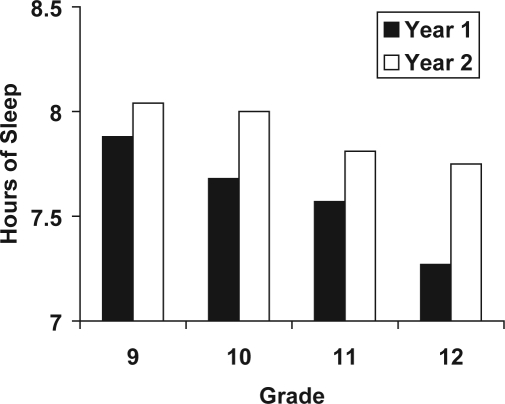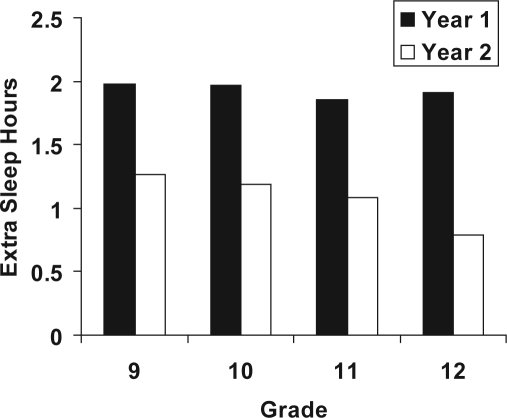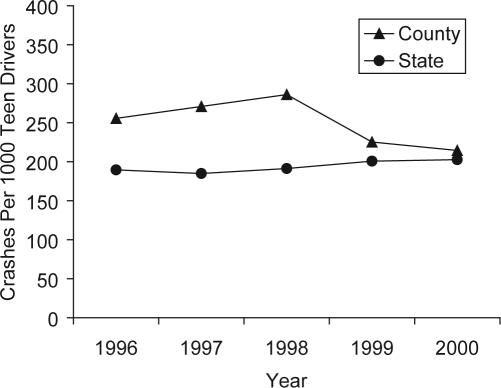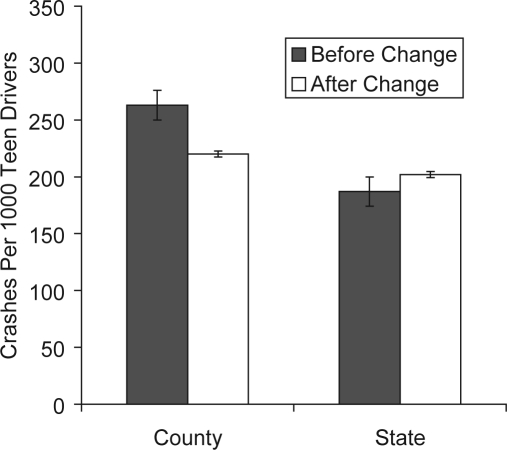Abstract
Study objectives:
To assess the effects of delayed high-school start times on sleep and motor vehicle crashes.
Methods:
The sleep habits and motor vehicle crash rates of adolescents from a single, large, county-wide, school district were assessed by questionnaire before and after a 1-hour delay in school start times.
Results:
Average hours of nightly sleep increased and catch-up sleep on weekends decreased. Average crash rates for teen drivers in the study county in the 2 years after the change in school start time dropped 16.5%, compared with the 2 years prior to the change, whereas teen crash rates for the rest of the state increased 7.8% over the same time period.
Conclusions:
Later school start times may both increase the sleep of adolescents and decrease their risk of motor vehicle crashes.
Citation:
Danner F; Phillips B. Adolescent sleep, school start times, and teen motor vehicle crashes. J Clin Sleep Med 2008;4(6):533–535.
Keywords: Adolescents, sleep deprivation, crash, public policy, school
There is considerable evidence that a majority of adolescents do not get enough sleep for optimal functioning during the day.1–3 It is also clear that driving while drowsy is a serious traffic safety problem, especially among young drivers.4–6 Both social and biologic pressures appear to cause a shift in sleep patterns during the transition to adolescence, with the result that adolescents stay up progressively later as they progress through high school.7–9 Therefore, early school start times for adolescents decrease their sleep, which increases their daytime sleepiness,8 which may, in turn, increase their odds of crashing their vehicles while driving.
Although concern is growing among sleep researchers about the detrimental effects of early school start times on adolescents, school scheduling is complex and emotionally laden.10 Any change in school start times affects the entire community, as it disrupts established child-care arrangements, extracurricular activities, work schedules, and family life. These logistical problems were evident in a recent national survey of secondary schools that reported that only 17% of high schools had even considered opting for later school start times in the preceding 3 years.11 Moreover, it is sometimes argued that starting high schools later will simply result in adolescents staying up even later, with no net gain in sleep, even though this did not appear to be the case in 3 recent studies.12–14
To assess the effects of delayed high school start times on sleep and motor vehicle crashes, a survey of the sleep habits of the students from an entire county-wide school district was administered before and after a change in school start times. There was only 1 school district in this county, and students from the entire district participated. State-collected measures of collision statistics by age and residence of driver were used to compute crash rates per 1000 licensed drivers for teen drivers before and after the change in school start times in both the county in which the start times changed and in the rest of the state, where start times remained unchanged.
METHODS
In April of Year 1 (1998), a total of 9,966 students from grades 6 to 12, who obtained parental permission, filled out questionnaires concerning their sleep habits on school and nonschool nights and various aspects of their daytime functioning. Specifically, the students were asked when they typically went to bed and arose on weekdays and on each day of the weekend, how many naps they took, how much difficulty they had staying awake in various situations (Epworth Sleepiness Scale), and how they spent their time before and after school. These Year 1 participants comprised 66.9% of the total population of middle- and high-school students enrolled in the county. In April of Year 2 (1999), 10,656 students (72.8% of the total middle- and high-school population) filled out the same questionnaire. Unfortunately, participant ID codes assigned by the school system were changed in 1999, so it was not possible to link individual students' responses over time. Therefore, analyses of change reported here are based on system-wide aggregate data. School start times during Year 1 were 07:30 and 08:00 for high schools and middle schools, respectively. In Year 2, high schools and middle schools started 1 hour later (08:30 and 09:00, respectively).
The data reported here focus on the sleep habits of high school students before and after the change in school start times, as well as on the rates of motor vehicle crashes of those students aged 17 to 18 years. Separate crash rates were computed for the county that changed high school start times and for the state as a whole (with the county data excluded). Crash rates were computed for the 5 years for which they were available—the 2 years prior to the school-start change (1996 and 1997) through 2 years following the school-start change (1999 and 2000). Results exclude 16-year-old drivers because Kentucky instituted a graduated drivers' license program in 1996 that severely restricts 16-year-olds' driving privileges. For their first 6 months, 16-year-olds may not drive after midnight and must have a licensed adult in the car with them at all times. These restrictions have resulted in a considerable decrease in crashes in the state among 16-year-olds but have not influenced crash rates for older teen drivers.15
RESULTS
Average hours of sleep per night during Year 1 and Year 2 are presented in Figure 1. These data reflect group average comparisons rather than individual students tracked over time. Students in Year 2 averaged from 12 minutes (Grade 9) to 30 minutes (Grade 12) more self-reported sleep, compared with students in Year 1. T-tests on these changes in average amount of sleep at each grade level indicate that these Year 1 to Year 2 gains were significant at all 4 grades (all p values < .001). The percentage of students who got at least 8 hours of sleep per weeknight increased significantly from 35.7% to 50.0% (p < .01), and the percentage who got at least 9 hours of sleep increased significantly from 6.3% to 10.8% (p < .01). The average amount of additional sleep on Friday nights, compared with school nights, served as a crude proxy for sleep deprivation, as catch-up sleep on the weekends is a logical response to the build-up of a sleep debt during the week.8 The average amount of this additional weekend sleep significantly decreased from 1.9 hours to 1.1 hours (p < .001), and this drop in extra catch-up sleep by grade level is illustrated in Figure 2. Consistent with this indication of a reduced sleep debt, average scores on the Epworth Sleepiness Scale decreased from 8.9 to 8.2 (p < .001) from Year 1 to Year 2, and the proportion of teens who scored 10 or higher dropped from 43.3% to 37% (p < .001).
Figure 1.
Hours of sleep per night by grade level and year.
Figure 2.
Hours of extra sleep on weekend nights by grade level and year.
There was little evidence of change from Year 1 to Year 2 on any other measure collected from the adolescents' self-reports. There was a slight increase in the percentage who reported working 10 hours or more per week (28% vs 31%), but there were no significant differences in hours spent on homework, school sports, organized community sports, music activities, volunteer work, or hanging out with friends.
Auto crash data per 1000 licensed drivers for those aged 17 and 18 are presented in Figures 3 and 4. Figure 3 presents all 5 years of available crash data and Figure 4 compares average crash rates for the 2 years prior to the change in school start times to those for the 2 years after the change. The year 1998 was dropped from Figure 4, as this was a transitional year during which the school district and the adolescents had to rearrange transportation to and from school. The county crash rates were considerably higher than the rest of the state prior to the change in school start times. This may have been because the study county is in the center of a rapidly expanding metropolitan area, with all of its attendant traffic congestion. Despite rapid population growth, the rate of crashes in the county dropped after the change in school start time. The average crash rates in the 2 years after the change in school start times, as shown in Figure 4, reflect a significant decrease of 16.5% in the study county (p < .01), whereas there was a significant increase of 7.8% across the same time period in the rest of the state (p < .01).
Figure 3.
Number of motor vehicle crashes per 1000 drivers aged 17 or 18 years in the study county and state.
Figure 4.
Number of motor vehicle crashes per 1000 drivers aged 17 or 18 years during the 2 years before and 2 years after a change in school start times.
DISCUSSION
Moving the school start time 1 hour later for all of the adolescents in 1 large county school district (the only county to do so during the period of this study) resulted in meaningful increases in sleep time, an increase in the percentage of students who got an adequate amount of sleep, and a decrease in catch-up sleep on weekends. It was also associated with a significant drop in auto collision rates for high school-aged drivers in that county, whereas crash rates increased in the rest of the state during the same time period. These findings are not necessarily causal, since they are not the result of a direct assessment of the sleep habits and miles driven of drivers who did and did not have crashes.
However, these data are consistent with the idea that allowing adolescents to sleep more on school nights by delaying the start of school not only results in them sleeping more, but also may have a measurable positive effect on their driving safety.
DISCLOSURE STATEMENT
This was not an industry supported study. The authors have indicated no financial conflicts of interest.
REFERENCES
- 1.Danner F. Adolescent sleep and daytime functioning: a national study. Sleep. 2000;23:A199–200. [Google Scholar]
- 2.Frederiksen K, Rhodes J, Reddy R, Way N. Sleepless in Chicago: tracking the effects of adolescent loss during the middle school years. Child Dev. 2004;75:84–95. doi: 10.1111/j.1467-8624.2004.00655.x. [DOI] [PubMed] [Google Scholar]
- 3.Wolfson A, Carskadon, M Sleep schedules and daytime functioning in adolescents. Child Dev. 1998;69:875–87. [PubMed] [Google Scholar]
- 4.McCartt A, Ribbner S, Pack A, Hammer M. The scope and nature of the drowsy driving problem in New York State. Accid Anal Prev. 1996;28:511–7. doi: 10.1016/0001-4575(96)00021-8. [DOI] [PubMed] [Google Scholar]
- 5.National Sleep Foundation. Washington, DC: WB&A Market Research; 2002. Sleep in America Poll. [Google Scholar]
- 6.Pack A, Rodgman E, Cucchiara, A, Dinges, D, Schwab, C Characteristics of crashes attributed to the driver having fallen asleep. Accid Anal Prev. 1995;27:769–75. doi: 10.1016/0001-4575(95)00034-8. [DOI] [PubMed] [Google Scholar]
- 7.Carskadon M, Acebo C. Regulation of sleepiness in adolescents: update, insights, and speculation. Sleep. 2002;25:606–14. doi: 10.1093/sleep/25.6.606. [DOI] [PubMed] [Google Scholar]
- 8.Carskadon M, Wolfson A, Acebo C, Tzischinsky O, Siefer R. Adolescent sleep patterns, circadian timing, and sleepiness at a transition to early school days. Sleep. 1998;21:871–81. doi: 10.1093/sleep/21.8.871. [DOI] [PubMed] [Google Scholar]
- 9.Wolfson A, Carskadon M. Understanding adolescents' sleep patterns and school performance: a critical appraisal. Sleep Med Rev. 2003;7:491–506. doi: 10.1016/s1087-0792(03)90003-7. [DOI] [PubMed] [Google Scholar]
- 10.Wahlstrom K. The prickly politics of school starting times. Phi Delta Kappan. 1999;80:345–7. [Google Scholar]
- 11.Wolfson A, Carskadon, M A survey of factors influencing high school start times. NASSP Bull. 2005;89:47–66. [Google Scholar]
- 12.Dexter D, Bijwadia J, Schilling D, Applebaugh G. WMJ: Official Publication of the State Medical Society of Wisconsin. Vol. 102. 2003. Sleep, sleepiness and school start times: a preliminary study; pp. 44–6. [PubMed] [Google Scholar]
- 13.Wahlstrom K. Later high-school start times still working. Education Digest. 2003;68:49–54. [Google Scholar]
- 14.Wolfson A. Middle school start times: the importance of a good night's sleep for young adolescents. Behav Sleep Med. 2007;5:194–209. doi: 10.1080/15402000701263809. [DOI] [PubMed] [Google Scholar]
- 15.Agent K, Pigman J, Steenbergen L, Pollack S, Kidd P, McCoy C. Research Report KTC-01-28/NHTSA1-98-1F. Lexington, KY: Kentucky Injury Prevention and Research Center; 2001. Evaluation of the Kentucky Graduated Driver Licensing System. [DOI] [PMC free article] [PubMed] [Google Scholar]






